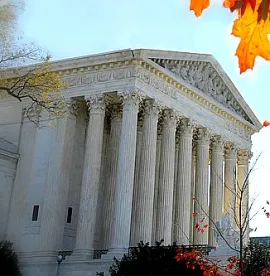As the President of the United States announced yesterday, in his sixteenth tweet of the day (out of twenty-five), "SUPREME COURT UPHOLDS TRUMP TRAVEL BAN. Wow!" Specifically, in Trump v. Hawaii (No. 17-965), the Court held that Proclamation No. 9645—the third iteration of what is generally known as the "Travel Ban"—is a lawful exercise of the broad discretion granted the President under the Immigration and Nationality Act to suspend the entry of aliens into the United States and that it does not violate the Establishment Clause, notwithstanding certain other tweets and statements from President (and candidate) Trump, suggesting that it was motivated by animus against Muslims. Given that the Court had already lifted a stay on the implementation of the Travel Ban, its ruling does not come as complete surprise. (Maybe that's why the President turned off all-caps for the "Wow!" exclamation in his celebratory tweet.) But the decision still offers an awful lot to digest. Heck, on top of standing and statutory construction and separation of powers and religious animus and nationwide injunctions, it appears the Court even stopped to overrule Korematsu v. United States (1944)! So we'll giving it solo billing in this Update (although we'll also touch upon a certain announcement made by Justice Kennedy, just as we were hitting "send").
The factual background of the case needs little rehearsing. Donald J. Trump is the President of the United States. Back when he was a candidate for this office, he issued a "Statement on Preventing Muslim Immigration," which called for a "total and complete shutdown of Muslims entering the United States." On several other occasions, he made statements suggesting a distrust of, or animus towards, Islam and Muslims, including that "Islam hates us" and that the United States was "having problems with Muslims coming into the country." Even after being elected, when asked whether violence in Europe had affected his plans to "ban Muslim immigration," the President replied, "You know my plans. All along, I've been proven right." Those "plans" coalesced one week after President Trump's inauguration, when he issued EO-1, the first iteration of the so-called Travel Ban. In relevant part, EO-1 suspended for 90 days the entry of foreign nationals from seven majority-Muslim countries, while the Department of Homeland Security undertook a review of vetting processes in those countries. EO-1 was promptly enjoined as a likely violation of the Establishment Clause and the President responded with EO-2, which largely mirrored the first iteration, except that Iraq was dropped from the list of affected countries. EO-2 also offered more explanation as to why the (now six) Muslim countries were selected—namely, because each has been designated a state sponsor of terrorism. The lower courts, however, didn't buy the additional justifications and EO-2 met the same fate as its predecessor. Exactly one year ago, on the last day of OT16, the Court granted cert to determine whether EO-2 was a lawful and constitutional exercise of the President's authority, but before the case could be argued, the Order expired on its own terms and was replaced by EO-3. The Court therefore dismissed the petitions as moot. The President signed the third iteration of the travel ban (technically a Proclamation, and referred to by the Court as such) on September 24, 2017, after the completion of the "worldwide review" called for by the first two executive orders. The Proclamation now targeted eight nations, including North Korea and Venezuela, which are not majority Muslim. The Proclamation also described how these states were selected for inclusion after a multi-agency review process. Although nationals of the eight selected countries were not permitted to enter the United States, the Proclamation contained various country-specific exceptions and conditions and provided for case-by-case waivers. As he had with the earlier Orders, the President issued the Proclamation pursuant to this authority under 8 U.S.C. § 1182(f), which permits the President to restrict the entry of aliens whenever he finds that their entry "would be detrimental to the interests of the United States."
Before the ink on President Trump's signature was dry, various challengers were back in court, including the State of Hawaii, which filed suit in the District of Hawaii, along with the Muslim Association of Hawaii and three individuals U.S. citizens who alleged that their family members were applying for visas but barred by the Proclamation from entering the United States. The challengers argued both that the Proclamation violated the Establishment Clause and that it violated the INA's prohibition on nationality-based discrimination. The District Court agreed with the statutory argument and issued a nationwide injunction barring enforcement of the Proclamation's entry restrictions. The Ninth Circuit affirmed on similar grounds. Meanwhile, in a separate challenge, the Fourth Circuit found the Proclamation unconstitutional, holding that it was motivated by religious animus against Muslims. The Court granted cert in the Hawaii case, but instructed the parties to brief the constitutional issue, in addition to the statutory issue and the Government's arguments about justiciability and the validity of the District Court's nationwide injunction.
Writing for the Court's conservative majority, the Chief Justice first ducked the question of justiciability. Though the Government had argued that the Court lacked authority to consider the statutory claims under the doctrine of consular nonreviewability, the Chief noted that the doctrine did not appear to be jurisdictional, so the Court was permitted to "assume without deciding" that the statutory claims were reviewable. Turning to that statutory argument, the Chief concluded that the Proclamation was a lawful exercise of the President's broad discretion under § 1182(f), a provision of the INA that "exudes deference" to the President. The only statutory limitation on the President's power, the Chief noted, was that he must "find[]" that the entry of aliens he wishes to exclude "would be detrimental to the interests of the United States." Given the multi-agency review process that purportedly took place between EO-1 and the Proclamation, the Chief concluded that this requirement was easily satisfied. The Chief rejected Hawaii's argument that § 1182(f) should be read narrowly so as not to conflict with other portions of the INA and concluded, in particular, that the Proclamation does not violate the INA's prohibition on nationality discrimination in the issuance of visas, because it only prohibits affected nationals from being admitted to the United States; they are still eligible for visas. (Here, we should pause to note, in the interest of full disclosure, that one of us submitted an amicus brief in support of Hawaii's statutory argument, which clearly did not impress the majority.)
Turning to the Establishment Clause, the Chief concluded that the individual plaintiffs did have standing to raise the constitutional challenge (a contested point), because "a person's interest in being united with his relatives is sufficiently concrete and particularized to form the basis of an Article III injury in fact. (The Court did not address whether the challengers might also have standing based on the "spiritual and dignitary" injury allegedly caused by the Proclamation.) However, the Chief rejected the challengers' argument that Candidate Trump's campaign statements (and certain post-inauguration statements and "retweets") showed that the primary purpose of the Proclamation was religious animus, notwithstanding its purported national security justification.
Those words—national security—weighed heavily in the Court's discussion of what standard of review to apply to the challengers' claims. While Establishment Clause claims are frequently subjected to a de novo "reasonable observer" standard, the Chief insisted that "[a]ny rule of constitutional law that would inhibit the flexibility of the President to respond to changing world conditions should be adopted only with the greatest caution," and therefore concluded that rational-basis review was appropriate. That pretty much spelled the end for the challengers, since—as the Chief acknowledged—"the Court hardly ever strikes down a policy as illegitimate under rational basis scrutiny." Instead, the Proclamation would be upheld "so long as it can reasonably understood to result from a justification independent of unconstitutional grounds." The standard was easily satisfied here, the Chief maintained, given the Proclamation's facial neutrality, the fact that it "covers just 8% of the world's Muslim population," and that it was the result of a "worldwide review process undertaken by multiple Cabinet officials and their agencies." While the challengers, and dissenters, characterized the review process as post-hoc pretext, the Chief refused to probe the stated, neutral justifications for the Proclamation and pointed out several features of the policy (including the various exceptions and waivers available and the fact that three majority-Muslim countries had already persuaded the Administration to remove them from the list) that supported the Government's claim that the Proclamation was justified by legitimate national-security interests, and not anti-Muslim animus.
Justice Kennedy joined the Court's opinion in full but wrote separately to suggest, in essence, that just because something is constitutional, doesn't make it right. "There are numerous instances in which the statements and actions of Government officials are not subject to judicial scrutiny or intervention. That does not mean those officials are free to disregard the Constitution and the rights it proclaims and protects. The oath that all officials take to adhere to the Constitution is not confined to those spheres in which the Judiciary can correct or even comment upon what those officials say or do. Indeed, the very fact that an official may have broad discretion, discretion free from judicial scrutiny, makes it all the more imperative for him or her to adhere to the Constitution and to its meaning and its promise." It is hard to escape the conclusion that these words were directed at the President, himself. (And, as it turns out, they amount to something of a swan song.***)
Justice Thomas also filed a concurring opinion to address the issue of nationwide injunctions, which he noted have become increasingly common in recent years. Though the majority had no occasion to reach the question, Justice Thomas explained that he is "skeptical that district courts have the authority to enter universal injunctions" and urged the Court to "address their legality" in a future case. Given the recent nationwide injunctions entered in the DACA and sanctuary-cities cases, there may well be an opportunity for the Court to take up the issue next term.
The dissenters split into two factions. Justice Breyer (joined only by Kagan), noted that the key issue in the case is "whether or the extent to which animus played a significant role in the Proclamations' promulgation or content." In his view, whether the Government was actually applying the elaborate system of exemptions and waivers that it touted at oral argument was a relevant data-point in deciding the ultimate issue in the case. And, he concluded, the evidence suggests that the Government is "not applying the Proclamation as written." In a letter to Senator Van Hollen, the State Department reported that, during the Proclamation's first month, only two waivers were approved out of 6,555 eligible applicants. And Justice Breyer took note of an affidavit filed in a pending case in the Eastern District of New York, in which a consular officer attested that "the waiver [process] is merely ‘window dressing'" and that officers "were not allowed to exercise [the] discretion" to grant waivers. While he acknowledged that "[d]eclarations, anecdotal evidence, and numbers taken from amicus briefs are not judicial factfindings," he argued that the Court should have remanded the case for further proceedings (leaving the injunction in effect in the meantime), "given the importance of the decision in this case [and] the need for assurance that the Proclamation does not rest upon a ‘Muslim ban.'" (In a term that has seen a lot of "special teams" activity, Justice Breyer's dissent reads like a blocked punt.) Nevertheless, as Justice Breyer pointed out, because the Court only vacated a preliminary injunction, the District Court remains "free to explore these issues on remand."
Justice Sotomayor (joined by Ginsburg, and only Ginsburg) penned a more passionate and comprehensive dissent, accusing the Court of failing to safeguard the "fundamental principle" of religious neutrality embedded in the First Amendment. Despite all the evidence that would lead a "reasonable observer [to] conclude that the Proclamation was motivated by anti-Muslim bias," the majority had strained to uphold it "by ignoring the facts, misconstruing our legal precedent, and turning a blind eye to the pain and suffering the Proclamation inflicts upon countless families and individuals, many of whom are United States citizens." The dissenters' main doctrinal source of disagreement with the majority was in the proper standard of review. In Justice Sotomayor's view, "[t]o determine whether plaintiffs have proved an Establishment Clause violation, the Court asks whether a reasonable observer would view the government action as enacted for the purpose of disfavoring a religion." She saw no reason to apply rational-basis review in this context merely because it involved immigration and national security. Justice Sotomayor spent seven pages of her dissent to recounting the various statements Trump had made (both as candidate and as President) suggesting a discriminatory motivation for the Proclamation, and concluded that "[t]aking all the relevant evidence together, a reasonable observer would conclude that the Proclamation was driven primarily by anti-Muslim bias, rather than by the Government's asserted national-security justifications." But even under rational-basis review, Justice Sotomayor maintained the Proclamation should fall, because it is "divorced from any factual context in which we could discern a relationship to legitimate state interests." Citing another amicus brief Wiggin and Dana contributed to in collaboration with Yale's Rule of Law Clinic, Justice Sotomayor pointed out that "several former national security officials from both parties . . . have advised that the Proclamation and its predecessor orders do not advance the national-security or foreign policy interests of the United States, and in fact do serious harm to those interests." Moreover, she pointed out, Congress "has already erected a statutory scheme [elsewhere in the INA] that fulfills the putative national-security interests the Government now puts forth to justify the Proclamation. Because "none of the features of the Proclamation highlighted by the majority supports the Government's claim that the Proclamation is genuinely and primarily rooted in a legitimate national-security interest," the inescapable conclusion remains "that the primary purpose and function of the Proclamation is to disfavor Islam by banning Muslims from entering our country." She concluded her dissent with a dig at the members of the majority who had seemingly taken an opposite view of official statements of religious animus in Masterpiece Cakeshop two week ago, and with a stark allusion to Korematsu v. United States (1944), in which a majority of the Supreme Court upheld President Roosevelt's executive order authorizing Japanese internment on national security grounds. "By blindly accepting the Government's misguided invitation to sanction a discriminatory policy motivated by animosity toward a disfavored group, all in the name of a superficial claim of national security," Justice Sotomayor accused the majority of "redeploy[ing] the same dangerous logic underlying Korematsu."
Although the Chief Justice parried many of the dissenting arguments in footnotes throughout his majority opinion, this one he addressed above the line. "Whatever rhetorical advantage the dissent may see in [drawing this comparison]," he maintained, "Korematsu has nothing to do with this case." But he continued: "The dissent's reference to Korematsu, however, affords this Court the opportunity to make express what is already obvious: Korematsu was gravely wrong the day it was decided, has been overruled in the court of history, and—to be clear—has no place in law under the Constitution." We'll count that as a "red flag" on Westlaw, 74 years after the Court's infamous decision. Whether Trump v. Hawaii will likewise live in infamy, or instead be remembered as a principled application of the usual law to an unusual President, remains to be seen.
***Postscript: Just as we were about to press "send" on this Update (after having reported earlier this morning that no retirement announcements were made on the last day of the term), news came that Justice Kennedy has given notice of his intent to retire from active service, effective July 31. In a letter addressed to the White House, he expressed his "profound gratitude for having had the privilege to seek in each case how best to know, interpret, and defend the Constitution and the laws that must always conform to its mandates and promises." Needless to say, the retirement of the swing justice on the Supreme Court is of profound consequence . . . and far outside our competence to discuss. But we'll certainly be watching and sharing how his decision impacts OT18.
In the meantime, though, there's still plenty more about OT17 to discuss. We'll be back soon!






 />i
/>i

